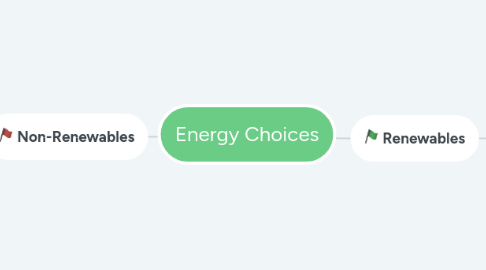
1. Renewables
1.1. Water
1.1.1. Hydroelectric Power: energy harvested from running water (rivers,lakes,ocean,etc.)
1.1.1.1. Advantages:
1.1.1.2. Disadvantages:
1.1.2. Tidal: the movement of sea water in and out of turbines
1.1.2.1. Advantages:
1.1.2.2. Disadvantages:
1.1.3. Wave:
1.1.3.1. Advantages:
1.1.3.2. Disadvantages:
1.2. Living Things
1.2.1. Biomass: decaying plants/animal waste used to produce methane
1.2.1.1. Advantages: Cheap, Long Term Sustainable Energy Source
1.2.1.2. Disadvantages: When Burned It Gives Off Greenhouse Gases, If Plants Not Replanted Biomass Is Non-Renewable
1.2.2. Wood: felling chopped trees and burning them to generate heat and light
1.2.2.1. Advantages: Long Term energy Source, Cheap
1.2.2.2. Disadvantages: Produces Greenhouse Gases, High Cost Of Transportation
1.3. Solar
1.3.1. Photovoltaic Cells: conversion of solar radiation to electricity through chemical energy
1.3.1.1. Advantages: Potential Infinite energy Supply, Safe To Use
1.3.1.2. Disadvantages: High Maintenance, Needs Sunshine
1.3.2. Concentrated Solar Power (CSP): focuses heat/energy to one point to generate a steam turbine to make electricity
1.3.2.1. Advantages: Solar Energy Is Renewable, Power Stations Cost Is Equivalent To Fossil Fuel Stations
1.3.2.2. Disadvantages: Relatively New Technology, Requires Area Of High Isolation
1.3.3. Passive: using buildings/pannels to capture and store heat
1.3.3.1. Advantages: Minimal Cost If Properly Designed
1.3.3.2. Disadvantages: Requires architects Who Can Design For Passive Solar Technologies
1.4. Wind: wind turbines turn wind energy into electricity
1.4.1. Advantages: Clean Energy Supply Once Turbines Made, Little Maintenance
1.4.2. Disadvantages: Questions if Birds/Winged Animals Negatively Affected By Turbines, Only Works When Windy
1.5. Geothermal: cold water is pumped into earth and comes out as steam.
1.5.1. Advantages: Potential Infinite Energy Supply, Used Successfully In Some Countries
1.5.2. Disadvantages: Only Works In Areas With Volcanic Activity, Geothermal energy May Calm Down
2. Non-Renewables
2.1. Fossil Fuels
2.1.1. Coal: fossilized plants laid down then mined from seams of coal then burned to provide energy.
2.1.1.1. Advantages: Cheap to mine, Needs no processing, Plentiful Supply.
2.1.1.2. Disadvantages: Cant be Replaced Once Used, Releases CO2 (Greenhouse Gas), Soot From Coal Produces Lung Disease, Coal Mines Lead To Land Polution.
2.1.2. Oil: fossilized plants and micro organisms found in rocks then extracted by oil wells. Afterwards its burned to supply energy for transportation (mostly)
2.1.2.1. Advantages: High Heat of Combustion, Many Uses
2.1.2.2. Disadvantages: Limited Supply, Gives Off CO2 When Burned, Risk of Oil Spills and Oil pipeline attacks (terrorism)
2.1.3. Natural Gas: methane gas trapped in between rocks and extracted by drilling then used in homes to produce domestic cooking and heating.
2.1.3.1. Advantages: High Heat of Combustion, Lots Of Energy Gaines From It, Cleaner Than Oil and Coal, Ready-Made Fuel.
2.1.3.2. Disadvantages: Limited Supply, Gives Off CO2 But Less Than Coal and Oil
2.2. Nuclear Power
2.2.1. Nuclear Fission: Uranium is mined then spit into nuclear reactors to produce massive amounts of energy
2.2.1.1. Advantages: Raw Material Is Cheap, Small Masses Of Material Produce High Amounts of Energy, No Pollutants/CO2 Released
2.2.1.2. Disadvantages: Extraction Costs High, Terrorism, Chance of Uranium Being Used For Weaponry, Nuclear Waste Is Radioactive and Toxic, Reactor Accidents
